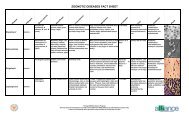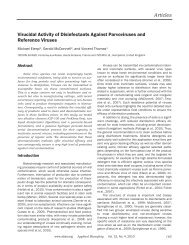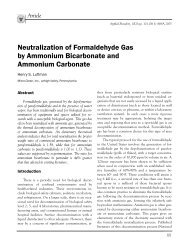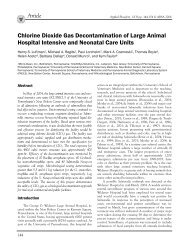Volume 10, Number 4, 2005 - American Biological Safety Association
Volume 10, Number 4, 2005 - American Biological Safety Association
Volume 10, Number 4, 2005 - American Biological Safety Association
You also want an ePaper? Increase the reach of your titles
YUMPU automatically turns print PDFs into web optimized ePapers that Google loves.
Biosafety Tips brings you practical approaches to<br />
biosafety or “news you can use.” If you are looking<br />
for a useful and sensible solution to a biocontainment<br />
problem or perhaps a reference to help convince<br />
a skeptical researcher of the need for caution,<br />
this is the place to look. In this column I will share<br />
some biosafety insights for managing a variety of<br />
workplace situations. I welcome feedback or suggestions<br />
for future topics. Please e-mail any comments<br />
or suggestions to karen_byers@dfci.harvard.edu or<br />
to Co-Editor Barbara Johnson at barbara_johnson@<br />
verizon.net.<br />
Lymphocytic Choriomeningitis Virus—<br />
A Hazard in Rodent Animal Colonies<br />
In April <strong>2005</strong>, a woman died of a stroke and<br />
after a thorough work-up, her organs were donated<br />
to four recipients. In May, state authorities notified<br />
the CDC that three of the transplant recipients had<br />
died, and the fourth was ill. Extensive testing revealed<br />
that lymphocytic choriomeningitis virus<br />
(LCMV) was present in the transplanted organs. Review<br />
of the organ donor’s history indicated that she<br />
had a new pet hamster, and the hamster was positive<br />
for LCMV infection. Although the donor had a subclinical<br />
(asymptomatic) infection, the immunosuppressed<br />
organ recipients developed fatal or serious<br />
infections from the infected organs (CDC, <strong>2005</strong>).<br />
To prevent disease transmission from pet rodents,<br />
CDC has posted advice at: www.cdc.gov/ncidod/<br />
dvrd/spb/mnpages/dispages/lcmv/owners.htm.<br />
Wild, or house, mice are a far more common<br />
source of LCMV. LCMV is a rodent-borne Arenavirus,<br />
and about 5% of adults living in urban populations<br />
have antibodies indicating previous exposure<br />
270<br />
Special Feature<br />
Biosafety Tips<br />
Karen B. Byers<br />
Dana Farber Cancer Institute, Boston, Massachusetts<br />
to LCMV (CDC, <strong>2005</strong>). Subclinical LCMV infection<br />
in a healthy adult may go unnoticed, but the<br />
virus may also produce a flu-like illness, or aseptic<br />
meningitis. LCMV is not spread from person to person,<br />
except that it may spread vertically from a pregnant<br />
woman to a developing fetus. Exposures during<br />
the first or second trimester are a serious risk to the<br />
fetus (CDC, <strong>2005</strong>). To protect the general public<br />
from the risk of contracting LCMV from wild rodents,<br />
the CDC has posted practical guidelines on<br />
the Web and provided detailed information in the<br />
publication Interim Guidance for Minimizing Risk for<br />
Human Lymphocytic Choriomeningitis Virus Infection<br />
Associated with Rodents (CDC, <strong>2005</strong>).<br />
Case Study 1<br />
In the occupational setting, animal facilities are<br />
carefully designed to prevent entry by wild mice and<br />
colonies are routinely screened for LCMV. In addition<br />
to the zoonotic risk, infection with LCMV can<br />
affect a wide range of research results (National Research<br />
Council, 1991). The following case study describes<br />
the chain of events that lead to an LCMV<br />
outbreak at a research institute in 1989 (Dykewicz et<br />
al., 1992).<br />
• In 1964, a cancer research institute developed a<br />
proprietary cancer cell line. This institute routinely<br />
injected the cell line into rodents to induce tumors<br />
in order to study metastasis.<br />
• In 1988, the institute began replacing the hamster<br />
animal model with nude mice.<br />
• A lapse in the routine serological monitoring of<br />
rodent colony health occurred between August 1988<br />
and March 1989. When the monitoring resumed,<br />
the oldest sentinel hamsters were positive for LCMV.







